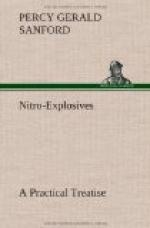Gun-cotton is also dissolved in acetone or acetic ether until it has taken the form of a jelly. It is then rolled into thin sheets, and when dry cut up into little squares. In the manufacture of smokeless powders from nitro-cellulose, nitro-lignine, &c., the various substances are mixed with the gun-cotton or collodion-cotton before granulating.
Collodion-Cotton.—In the manufacture of collodion or soluble cotton the finer qualities of cotton-waste are used and the acids used in the dipping tanks are much weaker. The manufacture of collodion-cotton has become of more importance than gun-cotton, by reason of its use for the manufacture of the various forms of gelatine, such as gelatine dynamite, gelignite, forcite, &c., and also on account of its extensive use in the manufacture of many of the smokeless powders. It is also used for the manufacture of “collodion,” which is a solution of collodion-cotton in ether-alcohol; for the preparation of celluloid, and many other purposes. It is less explosive than gun-cotton, and consists of the lower nitrates of cellulose. It is soluble in nitro-glycerine, and in a mixture of 2 parts of ether and 1 of alcohol; also in acetone, acetic ether, and other solvents. MM. Menard and Domonte were the first to prepare a soluble gun-cotton, and its investigation was carried on by Bechamp, who showed that its properties and composition were different to those of gun-cotton.
Manufacture.—The cotton used is cotton-waste.[A] It is thought by some that Egyptian cotton is preferable, and especially long fibre varieties. The strength of the acids used is, however, of more importance than the quality of the cotton. The percentage composition of the acid mixture which gives the best results is as follows:—Nitric acid, 23 per cent.; sulphuric acid, 66 per cent.; and water, 11 per cent; and has a specific gravity of 1.712 (about). It can be made by mixing sulphuric acid of specific gravity 1.84 with nitric acid of specific gravity 1.368




